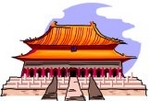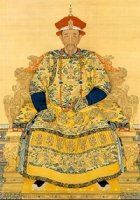
Worksheets and No Prep Teaching Resources
Reading Comprehension Worksheets
Ancient China

Ancient China
 Worksheets and No Prep Teaching Resources Reading Comprehension Worksheets Ancient China |
 Ancient China |
| edHelper's suggested reading level: | grades 8 to 12 | |
| Flesch-Kincaid grade level: | 9.26 |
|
Qing - China's Last Dynasty
By Vickie Chao |

|
 1 Looking back in history, there were only two times that a foreign ethnic tribe ruled the whole of China. The first was the Mongols, whose leader Kublai Khan established the Yuan dynasty in 1271 A.D. Kublai Khan and his successors' oppressive, authoritarian governing style didn't sit well with the Chinese, triggering numerous bouts of civil unrest. In 1368 A.D., Zhu Yuanzhang (a Chinese) orchestrated a revolution and toppled the Mongols. His Ming dynasty fell into turmoil in 1644 A.D., giving the Manchu, a nomadic tribe living in the northeast of present-day China, an opportunity to step up their effort of conquest. The Manchu (plural: Manchus or Manchu) succeeded and became the second foreign ethnic tribe to rule the whole of China. Its Qing dynasty (1644 A.D. - 1911 A.D.) also happens to be China's last dynasty.
1 Looking back in history, there were only two times that a foreign ethnic tribe ruled the whole of China. The first was the Mongols, whose leader Kublai Khan established the Yuan dynasty in 1271 A.D. Kublai Khan and his successors' oppressive, authoritarian governing style didn't sit well with the Chinese, triggering numerous bouts of civil unrest. In 1368 A.D., Zhu Yuanzhang (a Chinese) orchestrated a revolution and toppled the Mongols. His Ming dynasty fell into turmoil in 1644 A.D., giving the Manchu, a nomadic tribe living in the northeast of present-day China, an opportunity to step up their effort of conquest. The Manchu (plural: Manchus or Manchu) succeeded and became the second foreign ethnic tribe to rule the whole of China. Its Qing dynasty (1644 A.D. - 1911 A.D.) also happens to be China's last dynasty. |
Create Weekly Reading Books
Prepare for an entire week at once! |
| Leave your feedback on Qing - China's Last Dynasty (use this link if you found an error in the story) |
 |
Ancient China
|
 |
High School Reading Comprehensions and High School Reading Lessons
|
 |
Social Studies
|